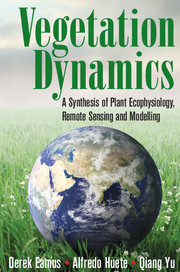Book contents
- Frontmatter
- Contents
- Preface
- Section One Plant Ecophysiology
- Section Two Remote Sensing
- Section Three Modelling
- Section Four Case Studies
- 14 Boreal Forests
- 15 Arid and Semi-Arid Grasslands
- 16 Savannas
- 17 Seasonal Behaviour of Vegetation of the Amazon Basin
- 18 Tropical Montane Cloud and Rainforests
- 19 Groundwater Dependent Ecosystems
- 20 Global-Change Drought and Forest Mortality
- Index
- References
18 - Tropical Montane Cloud and Rainforests
from Section Four - Case Studies
Published online by Cambridge University Press: 05 June 2016
- Frontmatter
- Contents
- Preface
- Section One Plant Ecophysiology
- Section Two Remote Sensing
- Section Three Modelling
- Section Four Case Studies
- 14 Boreal Forests
- 15 Arid and Semi-Arid Grasslands
- 16 Savannas
- 17 Seasonal Behaviour of Vegetation of the Amazon Basin
- 18 Tropical Montane Cloud and Rainforests
- 19 Groundwater Dependent Ecosystems
- 20 Global-Change Drought and Forest Mortality
- Index
- References
Summary
Introduction
Tropical montane cloud and rainforests are forests that occur at high elevation in tropical regions. They differ from tropical lowland forests because they experience low temperatures and because extensive mist and cloud cover alter the water and light environments compared to lowland forests. This chapter discusses the structure and behaviour of tropical montane forests (Fig. 18.1) and briefly compares these to lowland tropical forest.
Due to their terrain and relative isolation, tropical montane forests have not received the same level of intense ecophysiological, modelling, or remote sensing, study that lowland forests have received, although this is slowly changing. Consequently the majority of studies have been leaf- and tree-scale and field-based. Eddy covariance methods have not been routinely applied to-date but developments in using remote sensing techniques with corrections for the influence of altitude, aspect and slope are occurring.
Light, nutrient and temperature effects have major impacts on the ecophysiology, productivity and structure of tropical montane forests. Foliar uptake of water makes a significant contribution to the water status of the canopy.
The questions addressed in this chapter include the following: Where do tropical montane forests occur? What leaf- and canopy-scale adaptations occur that allow montane forests to grow at altitude? Does photosynthetic capacity vary with altitude and what are the patterns in ET and productivity in these forests? Finally, this chapter addresses the question: do mist and clouds supply water directly to the canopy through foliar uptake?
Types of Tropical Montane Cloud and Rainforests
The case study of Amazonian rainforest (Chapter 17) focuses on seasonality of rainfall, phenological patterns and the impacts of drought on Amazonian rainforest productivity. That chapter examined the environmental controls of productivity in lowland tropical rainforest. In contrast, this case study examines tropical montane cloud and rainforest where the controls of productivity are generally temperature, light availability and sometimes, soil nutrient supply.
Tropical montane cloud and rainforests occur at elevation in the tropics and are characterised as being shrouded in fog/cloud for a large fraction of the year. They have very large levels of endemism, very high levels of species richness, and are the source of large volumes of high quality drinking water for lower elevation sites. Cloud forests may increase the water yield of high altitude catchments through canopy interception and capture of cloud/fog water and through the suppression of evapotranspiration that occurs because of the presence of cloud/fog.
- Type
- Chapter
- Information
- Vegetation DynamicsA Synthesis of Plant Ecophysiology, Remote Sensing and Modelling, pp. 442 - 459Publisher: Cambridge University PressPrint publication year: 2016

